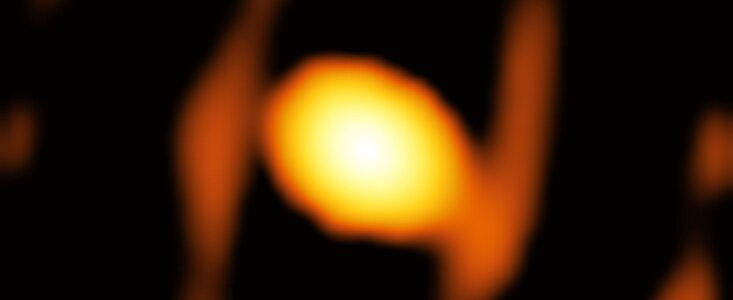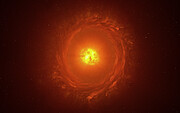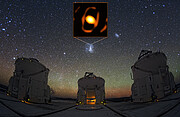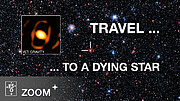Comunicato Stampa
Gli astronomi scattano la prima foto ravvicinata di una stella al di fuori della nostra galassia
21 Novembre 2024
"Per la prima volta, siamo riusciti a scattare l'immagine ingrandita di una stella morente in una galassia al di fuori della Via Lattea", afferma Keiichi Ohnaka, astrofisico dell'Universidad Andrés Bello in Cile. Situata a ben 160 000 anni luce da noi, la stella WOH G64 è stata immortalata grazie alla notevole nitidezza offerta dal VLTI dell'ESO (il Very Large Telescope Interferometer dell'Osservatorio Europeo australeI. Le nuove osservazioni rivelano una stella che sbuffa via gas e polvere, nelle ultime fasi prima di diventare una supernova.
"Abbiamo scoperto un bozzolo ovoidale che circonda da vicino la stella", afferma Ohnaka, autore principale di uno studio che riporta le osservazioni pubblicate oggi su Astronomy & Astrophysics. "Siamo emozionati perché questo bozzolo potrebbe essere legato alla drastica espulsione di materia dalla stella morente prima di un'esplosione di supernova".
Mentre gli astronomi hanno scattato qualche decina di immagini ingrandite di stelle della nostra galassia, svelandone le proprietà, innumerevoli altre stelle vivono in altre galassie, così lontane che osservarne anche una sola in dettaglio è stato estremamente impegnativo. Fino ad ora.
La stella appena immortalata, WOH G64, si trova all'interno della Grande Nube di Magellano, una delle piccole galassie che orbitano intorno alla Via Lattea. Gli astronomi conoscono questa stella da decenni e l'hanno opportunamente soprannominata "colosso". Con una dimensione di circa 2000 volte quella del Sole, WOH G64 è classificata come una supergigante rossa.
Il gruppo di Ohnaka era da tempo interessato a questa stella colossale. Nel 2005 e nel 2007 hanno utilizzato il VLTI dell'ESO nel deserto di Atacama in Cile per approfondire le caratteristiche della stella e hanno continuato a studiarla negli anni successivi. Ma una vera immagine della stella non era ancora stata scattata.
Per ottenere la tanto desiderata immagine, l'equipe ha dovuto attendere lo sviluppo di uno degli strumenti di seconda generazione del VLTI, GRAVITY. Dopo aver confrontato i nuovi risultati con altre precedenti osservazioni di WOH G64, sono rimasti sorpresi nello scoprire che la stella era diventata più fioca nell'ultimo decennio.
"Abbiamo scoperto che la stella ha subito un cambiamento significativo negli ultimi 10 anni, offrendoci una rara opportunità di assistere alla vita di una stella in tempo reale", afferma Gerd Weigelt, professore di astronomia presso il Max Planck Institute for Radio Astronomy di Bonn, in Germania e coautore dello studio. Nelle fasi finali della vita, le supergiganti rosse come WOH G64 perdono i propri strati esterni di gas e polvere per mezzo di un processo che può durare migliaia di anni. "Questa stella è una delle più estreme del suo genere e qualsiasi cambiamento drastico potrebbe avvicinarla a una fine esplosiva", aggiunge il coautore Jacco van Loon, direttore dell'Osservatorio Keele presso la Keele University, Regno Unito, che osserva WOH G64 dagli anni '90.
L'equipe ritiene che questi materiali persi possano essere responsabili anche dell'abbassamento della luminosità e della forma inattesa del bozzolo di polvere intorno alla stella. La nuova immagine mostra che il bozzolo è allungato, il che ha sorpreso gli scienziati, che si aspettavano una forma diversa in base alle osservazioni precedenti e ai modelli computazionali. Il gruppo ritiene che la forma ovoidale del bozzolo potrebbe essere spiegata dalla perdita di materia della stella o dall'influenza di una stella compagna ancora da scoprire.
A mano a mano che la stella diventa più debole, scattare altre foto ravvicinate sta diventando sempre più difficile, persino per il VLTI. Tuttavia, gli aggiornamenti della strumentazione del telescopio già pianificati, come il futuro GRAVITY+, promettono di cambiare presto questa situazione. "Analoghe osservazioni di approfondimento con gli strumenti dell'ESO saranno importanti per comprendere cosa sta succedendo nella stella", conclude Ohnaka.
Ulteriori Informazioni
Il VLTI (Very Large Telescope Interferometer) dell'ESO può combinare la luce raccolta dai telescopi del VLT (Very Large Telescope) dell'ESO, sia i quattro telescopi principali da 8 metri (UT), sia i quattro telescopi ausiliari più piccoli (AT), producendo immagini dettagliatissime del cosmo. Di fatto, questo rende il VLTI un telescopio “virtuale” con una risoluzione equivalente alla massima distanza tra i singoli telescopi. Questo processo è molto complesso e richiede strumenti appositamente dedicati. Già nel 2005 e nel 2007 il gruppo di Ohnaka ha avuto accesso a uno di questi strumenti di prima generazione: MIDI. Pur avendo una resa notevolissima per l'epoca, quelle osservazioni combinavano la luce di soli due telescopi. Ora, i ricercatori hanno accesso a GRAVITY, uno strumento di seconda generazione in grado di combinare la luce di quattro telescopi. La miglior sensibilità e risoluzione hanno reso possibile ottenre l’immagine di WOH G64. Ma c’è di più. GRAVITY+, già pianificato, rappresenta l'aggiornamento di GRAVITY e potrà sfruttare diversi miglioramenti tecnologici effettuati al VLTI e al VLT e di conseguenza il VLTI sarà in grado di osservare oggetti più deboli e più distanti.
Questo lavoro è stato presentato in un articolo pubblicato da Astronomy and Astrophysics (https://www.aanda.org/10.1051/0004-6361/202451820).
L'equipe è composta da: K. Ohnaka (Instituto de Astrofísica, Departamento de Física y Astronomía, Facultad de Ciencias Exactas, Universidad Andrés Bello, Cile), K.-H. Hofmann (Max Planck Institute for Radio Astronomy, Bonn, Germania [MPIfR]), G. Weigelt (MPIfR), J. Th. van Loon (Lennard-Jones Laboratories, Keele University, Regno Unito), D. Schertl (MPIfR), S. R. Goldman (Space Telescope Science Institute, Baltimore, USA).
L'ESO (European Southern Observatory o Osservatorio Europeo Australe) consente agli scienziati di tutto il mondo di scoprire i segreti dell'Universo a beneficio di tutti. Progettiamo, costruiamo e gestiamo da terra osservatori di livello mondiale - che gli astronomi utilizzano per affrontare temi interessanti e diffondere il fascino dell'astronomia - e promuoviamo la collaborazione internazionale per l'astronomia. Fondato come organizzazione intergovernativa nel 1962, oggi l'ESO è sostenuto da 16 Stati membri (Austria, Belgio, Danimarca, Francia, Finlandia, Germania, Irlanda, Italia, Paesi Bassi, Polonia, Portogallo, Regno Unito, Repubblica Ceca, Spagna, Svezia e Svizzera), insieme con il paese che ospita l'ESO, il Cile, e l'Australia come partner strategico. Il quartier generale dell'ESO e il Planetario e Centro Visite Supernova dell'ESO si trovano vicino a Monaco, in Germania, mentre il deserto cileno di Atacama, un luogo meraviglioso con condizioni uniche per osservare il cielo, ospita i nostri telescopi. L'ESO gestisce tre siti osservativi: La Silla, Paranal e Chajnantor. Sul Paranal, l’ESO gestisce il VLT (Very Large Telescope) e il VLTI (Very Large Telescope Interferometer), così come telescopi per survey come VISTA. Sempre a Paranal l'ESO ospiterà e gestirà la schiera meridionale di telescopi di CTA, il Cherenkov Telescope Array Sud, il più grande e sensibile osservatorio di raggi gamma del mondo. Insieme con partner internazionali, l’ESO gestisce APEX e ALMA a Chajnantor, due strutture che osservano il cielo nella banda millimetrica e submillimetrica. A Cerro Armazones, vicino a Paranal, stiamo costruendo "il più grande occhio del mondo rivolto al cielo" - l'ELT (Extremely Large Telescope, che significa Telescopio Estremamente Grande) dell'ESO. Dai nostri uffici di Santiago, in Cile, sosteniamo le operazioni nel paese e collaboriamo con i nostri partner e la società cileni.
La traduzione dall'inglese dei comunicati stampa dell'ESO è un servizio dalla Rete di Divulgazione Scientifica dell'ESO (ESON: ESO Science Outreach Network) composta da ricercatori e divulgatori scientifici da tutti gli Stati Membri dell'ESO e altri paesi. Il nodo italiano della rete ESON è gestito da Anna Wolter.
Links
- Articolo scientifico
- Fotografie del VLT e del VLTI
- Per i giornalisti: iscrivetevi per ricevere i nostri comunicati sotto embargo nella vostra lingua
- Per i ricercatori: avete una storia da raccontare? Inviateci il vostro articolo scientifico
Contatti
Keiichi Ohnaka
Universidad Andrés Bello
Santiago, Chile
Tel.: +56-9522 39623
E-mail: k1.ohnaka@gmail.com
Gerd Weigelt
Max Planck Institute for Radio Astronomy
Bonn, Germany
Tel.: +49 228 525 243
E-mail: gweigelt@mpifr-bonn.mpg.de
Jacco van Loon
Keele University
Keele, UK
Tel.: +44 1782 733331
E-mail: j.t.van.loon@keele.ac.uk
Bárbara Ferreira
ESO Media Manager
Garching bei München, Germany
Tel.: +49 89 3200 6670
Cell.: +49 151 241 664 00
E-mail: press@eso.org
Anna Wolter (press contact Italia)
Rete di divulgazione scientifica dell'ESO
e INAF-Osservatorio Astronomico di Brera
Milano, Italy
Tel.: +39 02 72320321
E-mail: eson-italy@eso.org
Sul Comunicato Stampa
| Comunicato Stampa N": | eso2417it |
| Nome: | WOH G64 |
| Tipo: | Local Universe : Star : Circumstellar Material |
| Facility: | Very Large Telescope Interferometer |
| Instruments: | GRAVITY |
| Science data: | 2024A&A...691L..15O |
Our use of Cookies
We use cookies that are essential for accessing our websites and using our services. We also use cookies to analyse, measure and improve our websites’ performance, to enable content sharing via social media and to display media content hosted on third-party platforms.
ESO Cookies Policy
The European Organisation for Astronomical Research in the Southern Hemisphere (ESO) is the pre-eminent intergovernmental science and technology organisation in astronomy. It carries out an ambitious programme focused on the design, construction and operation of powerful ground-based observing facilities for astronomy.
This Cookies Policy is intended to provide clarity by outlining the cookies used on the ESO public websites, their functions, the options you have for controlling them, and the ways you can contact us for additional details.
What are cookies?
Cookies are small pieces of data stored on your device by websites you visit. They serve various purposes, such as remembering login credentials and preferences and enhance your browsing experience.
Categories of cookies we use
Essential cookies (always active): These cookies are strictly necessary for the proper functioning of our website. Without these cookies, the website cannot operate correctly, and certain services, such as logging in or accessing secure areas, may not be available; because they are essential for the website’s operation, they cannot be disabled.
Functional Cookies: These cookies enhance your browsing experience by enabling additional features and personalization, such as remembering your preferences and settings. While not strictly necessary for the website to function, they improve usability and convenience; these cookies are only placed if you provide your consent.
Analytics cookies: These cookies collect information about how visitors interact with our website, such as which pages are visited most often and how users navigate the site. This data helps us improve website performance, optimize content, and enhance the user experience; these cookies are only placed if you provide your consent. We use the following analytics cookies.
Matomo Cookies:
This website uses Matomo (formerly Piwik), an open source software which enables the statistical analysis of website visits. Matomo uses cookies (text files) which are saved on your computer and which allow us to analyze how you use our website. The website user information generated by the cookies will only be saved on the servers of our IT Department. We use this information to analyze www.eso.org visits and to prepare reports on website activities. These data will not be disclosed to third parties.
On behalf of ESO, Matomo will use this information for the purpose of evaluating your use of the website, compiling reports on website activity and providing other services relating to website activity and internet usage.
Matomo cookies settings:
Additional Third-party cookies on ESO websites: some of our pages display content from external providers, e.g. YouTube.
Such third-party services are outside of ESO control and may, at any time, change their terms of service, use of cookies, etc.
YouTube: Some videos on the ESO website are embedded from ESO’s official YouTube channel. We have enabled YouTube’s privacy-enhanced mode, meaning that no cookies are set unless the user actively clicks on the video to play it. Additionally, in this mode, YouTube does not store any personally identifiable cookie data for embedded video playbacks. For more details, please refer to YouTube’s embedding videos information page.
Cookies can also be classified based on the following elements.
Regarding the domain, there are:
- First-party cookies, set by the website you are currently visiting. They are stored by the same domain that you are browsing and are used to enhance your experience on that site;
- Third-party cookies, set by a domain other than the one you are currently visiting.
As for their duration, cookies can be:
- Browser-session cookies, which are deleted when the user closes the browser;
- Stored cookies, which stay on the user's device for a predetermined period of time.
How to manage cookies
Cookie settings: You can modify your cookie choices for the ESO webpages at any time by clicking on the link Cookie settings at the bottom of any page.
In your browser: If you wish to delete cookies or instruct your browser to delete or block cookies by default, please visit the help pages of your browser:
Please be aware that if you delete or decline cookies, certain functionalities of our website may be not be available and your browsing experience may be affected.
You can set most browsers to prevent any cookies being placed on your device, but you may then have to manually adjust some preferences every time you visit a site/page. And some services and functionalities may not work properly at all (e.g. profile logging-in, shop check out).
Updates to the ESO Cookies Policy
The ESO Cookies Policy may be subject to future updates, which will be made available on this page.
Additional information
For any queries related to cookies, please contact: pdprATesoDOTorg.
As ESO public webpages are managed by our Department of Communication, your questions will be dealt with the support of the said Department.






